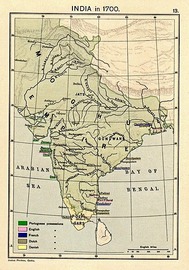en.wikipedia.org
Always private
DuckDuckGo never tracks your searches.
Learn MoreYou can hide this reminder in Search Settings
All regions
Argentina
Australia
Austria
Belgium (fr)
Belgium (nl)
Brazil
Bulgaria
Canada (en)
Canada (fr)
Catalonia
Chile
China
Colombia
Croatia
Czech Republic
Denmark
Estonia
Finland
France
Germany
Greece
Hong Kong
Hungary
Iceland
India (en)
Indonesia (en)
Ireland
Israel (en)
Italy
Japan
Korea
Latvia
Lithuania
Malaysia (en)
Mexico
Netherlands
New Zealand
Norway
Pakistan (en)
Peru
Philippines (en)
Poland
Portugal
Romania
Russia
Saudi Arabia
Singapore
Slovakia
Slovenia
South Africa
Spain (ca)
Spain (es)
Sweden
Switzerland (de)
Switzerland (fr)
Taiwan
Thailand (en)
Turkey
Ukraine
United Kingdom
US (English)
US (Spanish)
Vietnam (en)
Safe search: moderate
Strict
Moderate
Off
Any time
- Was this helpful?
- The Mughal Empire was an early modern empire in South Asia. At its peak, the empire stretched from the outer fringes of the Indus River Basin in the west, northern Afghanistan in the northwest, and Kashmir in the north, to the highlands of present-day Assam and Bangladesh in the east, and the uplands of the Deccan Plateau in South India. [7] [8]The Mughal Empire is conventionally said to have ...
britannica.com
Jan 7, 2025Mughal dynasty, Muslim dynasty of Turkic-Mongol origin that ruled most of northern India from the early 16th to the mid-18th century. The administrative organization of the Mughal Empire allowed it to prosper for more than two centuries before being overrun by the Marathas. The British exiled the last Mughal.Author:The Editors of Encyclopaedia Britannicabritannica.com
5 days agoThe Mughal Empire at its zenith commanded resources unprecedented in Indian history and covered almost the entire subcontinent. From 1556 to 1707, during the heyday of its fabulous wealth and glory, the Mughal Empire was a fairly efficient and centralized organization, with a vast complex of personnel, money, and information dedicated to the service of the emperor and his nobility.en.wikipedia.org
The Mughal dynasty (Persian: دودمان مغل, romanized: Dudmân-e Mughal) or the House of Babur (Persian: خاندانِ آلِ بابُر, romanized: Khāndān-e-Āl-e-Bābur), was a branch of the Timurid dynasty founded by Babur that ruled the Mughal Empire from its inception in 1526 till the early eighteenth century, and then as ceremonial suzerains over much of the empire until 1857.historyskills.com
The Mughal Empire was one of the most powerful empires in the world for centuries. It was founded in 1526 by Babur and, at its peak, spanned from the Deccan in the south to the Himalayas in the north, and from the eastern parts of present-day India to the western regions of Afghanistan. The Mughals were Muslims, and their empire was marked by a blend of Islamic and Indian cultures. Under Akbar ...vajiramandravi.com
The Mughal Empire ruled large parts of the Indian subcontinent from the early 16th to mid-19th centuries. Founded in 1526 by Babur, a Timurid prince descended from Turkic-Mongol ancestors, the Mughal dynasty expanded its territories under influential rulers like Akbar, Jahangir, Shah Jahan, and Aurangzeb.The Mughals ushered in an era of political unity, military strength, architectural marvels ...februarytoend.com
februarytoend.com
https://februarytoend.com › the-mughal-empire
Dec 7, 2024The Mughal Empire, spanning over three centuries, stands as one of the most influential dynasties in the history of the Indian subcontinent. Its legacy includes contributions to art, culture, architecture, governance, and a profound influence on the socio-political fabric of the region.newworldencyclopedia.org
New World Encyclopedia
https://www.newworldencyclopedia.org › entry › Mughal_Empire
The Mughal Empire, (Persian language: مغل بادشاۿ) was an empire that at its greatest territorial extent ruled parts of Afghanistan, Balochistan and most of the Indian Subcontinent between 1526 and 1857.The empire was founded by the Mongol leader Babur in 1526, when he defeated Ibrahim Lodi, the last of the Afghan Lodi Sultans at the First Battle of Panipat, where they used gunpowder ...britannica.com
Tom Nebbia-Aspect Picture Library The reign of Jahāngīr's son Shah Jahān marks the cultural zenith of the Mughal Empire. Shah Jahān develops a passion for building. The Taj Mahal of Agra, one of the most beautiful structures in the world, is built by Shah Jahān as a mausoleum for his wife Mumtaz Mahal. At Delhi Shah Jahān builds a huge fortress-palace complex called the Red Fort as ...history-maps.com
The Mughal Empire, founded in 1526 by Babur, a chieftain from present-day Uzbekistan, marked a significant era in South Asia. Babur, with aid from the Safavid and Ottoman Empires, defeated the Sultan of Delhi, Ibrahim Lodi, at the First Battle of Panipat, establishing his rule in North India.The empire's formal imperial structure is often dated from 1600 under Akbar, Babur's grandson, and ...Can’t find what you’re looking for?
Help us improve DuckDuckGo searches with your feedback
